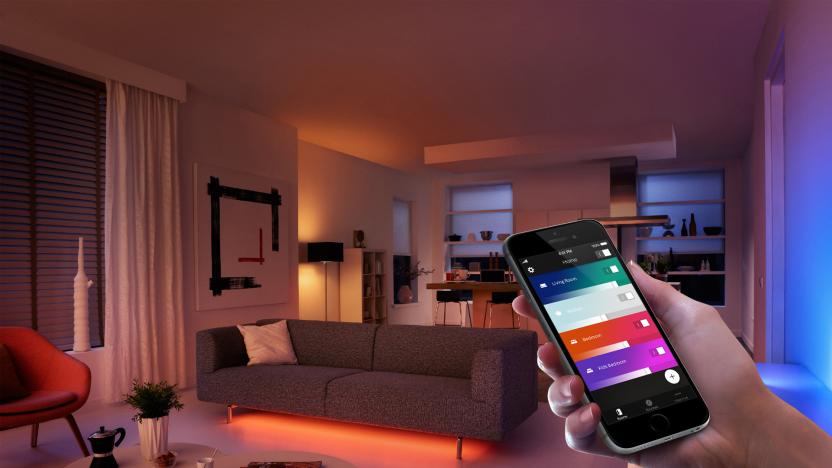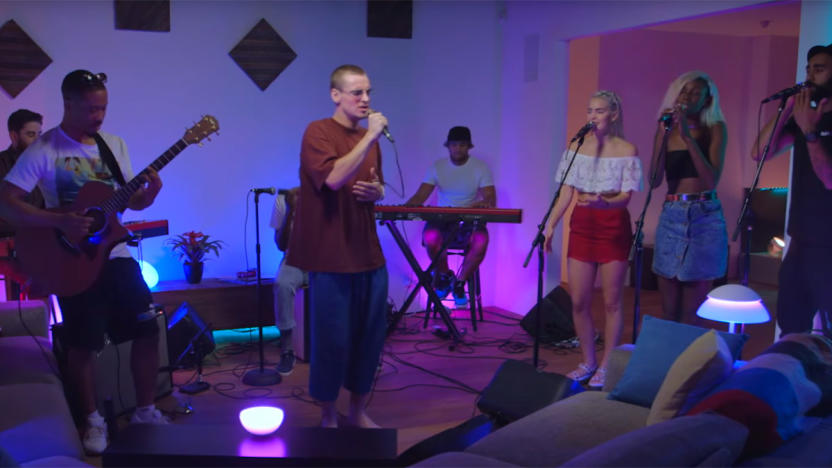lighting
Latest

Philips' Hue 2.0 app adds a host of new 'smart' features
Philips unveiled an app update for its Hue smart lights on Thursday. The iOS- and Android-ready program has been completely revamped, including a new UI.

LED-lit fishing nets save sea turtles from getting caught
Sometimes, it's the simplest tech that makes the biggest difference. University of Exeter researchers have crafted fishing nets with evenly distributed green LED lights (one every 33 feet) that warn sea turtles away without spooking fish. While scientists have yet to nail the exact reason the lights steer the turtles clear, one researcher tells Tech Insider that it's likely just a matter of visibility -- the turtles stand a better chance of seeing the net in time to avoid it. It's not only quite effective in early tests (it reduced green turtle deaths by 64 percent), but relatively cheap at $100 to cover a giant 1,640ft net with 50 lights.

Philips' latest Hue lights help you sleep
Philips has smart Hue light bulbs that produce flashy colors, but what about bulbs that change just enough to give you a good night's rest? You're set after today. The lighting firm is trotting out Hue white ambiance lights that offer color temperatures which mimic natural light, helping you sleep naturally. Combined with new "routines" in an upcoming version of the Hue app, they can shift gradually to reflect day and night cycles -- a sleep mode can use dimming light to replicate the sunset, for example, while "wake up" brightens the area. There's even a nightlight mode to help kids get back to sleep after wandering the hallway. Logically, the new Hue offering should also be useful for creating different moods. You could have cool, crisp lighting in a workspace, or warmer temperatures in the living room.

Smart cube lamp shows emoji and sets the mood
LED cube lamps have been around for a while, but they tend to either be make-it-yourself affairs or limited in what they can do. However, Spin-R might finally bring that lighting tech to your living room. It's crowdfunding Tittle (yes, we know), a 512-light lamp that you can program to do your bidding. You can customize its patterns and colors to set the mood for a movie or house party, but the real fun starts when it talks to the outside world. It can pulse in sync with your music -- conversation starter, anyone? -- and you can send 3D emoji to other Tittle owners to share what you're thinking.

Philips won't block third-party Hue bulbs after all
Well, that was fast. After announcing that it would drop support for third-party Hue bulbs, Philips is reversing its decision. The company initially nixed support for bulbs that weren't certified by its Friend of Hue program that ensures products from other brands don't cause any issues with the lighting setups. However, Philips says that it "underestimated the impact" on customers and a second software update is on the way to reverse this week's action. It also reminded users that using third-party bulbs may lead to the same incompatibility issues as before, such as not dimming properly or creating the correct colors.[Image credit: Jasper Juinen/Bloomberg via Getty Images]

Philips Hue won't work with third-party light bulbs for now
Bad news if you're planning to slip a few non-Philips light bulbs into your Hue setup: they won't work, at least not for a while. Philips has dropped support for third-party bulbs after noticing that a growing number of them had "interoperability issues" preventing them from playing nicely with official Hue gear. Support will come back, but only through a Friends of Hue program that will certify lighting. Any existing lights you're using will work, Philips is quick to note -- it's only new, untested additions that are getting the boot.

Watch Philips and Rudimental meld smart lighting with music
If you were making connected lighting, how would you convey the concept to the public? Philips thinks it has a way. It just launched the Living Light Sessions, a series of performances that has musicians putting on a light show with Hue bulbs while they play. The music is great, as an inaugural video from UK outfit Rudimental shows, although the link between music and smart lights is a bit strained -- while Hue is supposed set a "laid-back mood" for the gig, it mostly amounts to a lot of blue and purple in a studio. If nothing else, though, this could serve as a friendly reminder that Philips' technology is good for more than just impressing your friends.

Philips Hue now responds to your Siri commands
One of the frustrations of choosing an Internet of Things device is finding one that plays well with the other smart appliances in your home. Philips' Hue lighting platform is already pretty extensible, but today it's finally gained support for another big partner: Apple. With its new Homekit-enabled bridge, Philips will let you control your lighting via Siri (and supporting third-party apps), whether your bulbs are old or new.

Philips' latest Hue kit gives you wireless light dimming
Dimmable lights can add an air of sophistication to your abode, but setting them up? Not fun -- not unless you enjoy messing with home wiring or paying a lot of money. Philips might have a better way, though. It's trotting out a wireless dimming kit that turns any white Hue bulb (one is included in the box) into a dimmable light. The only real challenge is finding a place to mount the holder for the battery-powered remote switch. After that, you can dim as many as 10 bulbs at once just by clicking buttons. The kit will cost you $40 when it arrives in North America this September. That's not a trivial outlay, but it's inexpensive enough that you may be tempted to skip plug-in dimming kits or in-wall installations.

This super-thin OLED desk lamp will also charge your phone
Do you take your desk lighting seriously? Really seriously? You'll want to look at Aerelight's just-shipped A1 desk lamp, then. The eye-catching design uses an OLED panel to illuminate your room, which both makes it wafer-thin and produces a natural-looking, energy-efficient glow that should last as long as the lamp itself. You shouldn't have to touch anything but the controls for the next 20 years, according to Aerelight. And did we mention that it'll wirelessly charge your phone? In a seeming bid to one-up IKEA, the A1 can top up mobile devices using either the Qi or PMA charging standards.

Disney explains why its 3D animation looks so realistic
Have you watched 3D-animated Disney flicks like Big Hero 6 and wondered how some of its scenes manage to look surprisingly realistic? Today's your lucky day: Disney has posted a top-level explanation of how its image rendering engine, Hyperion, works its movie magic. The software revolves around "path tracing," an advanced ray tracing technique that calculates light's path as it bounces off objects in a scene. It takes into account materials (like Baymax's translucent skin), and saves valuable time by bundling light rays that are headed in the same direction -- important when Hyperion is tracking millions of rays at once. The technology is efficient enough that animators don't have to 'cheat' when drawing very large scenes, like BH6's picturesque views of San Fransokyo. Although Disney's tech still isn't perfectly true to life, it's close enough that the studio might just fool you in those moments when it strives for absolute accuracy.

Philips' Hue lights sync up with an Xbox One game
You can get Philips' Hue lights to change color when you're watching movies, so it only makes sense that they should also put on a show when you're playing games, right? Frima certainly thinks so. The studio has just added Hue syncing to its Xbox One platformer Chariot, adding an extra level of atmosphere to your adventures. When enemies attack, your bulbs will turn red; when you wander by blooming plants, the living room might go green. This isn't the first time that we've seen Hue gaming experiences, and it's definitely not a cheap trick when a starter Hue kit typically costs $200. However, this is probably the easiest way to ramp up the atmospheric effects while you play. Here's hoping that more games experiment with lighting in the future.

Logitech remotes can turn down Hue lights before movie night
Logitech's Harmony remote just got considerably more useful when you're setting the mood for a movie. A recent hub firmware update (available through the Android and iOS apps) for its Smart Control and Ultimate remotes lets you adjust Philips' Hue lights at the start or end of an activity. You can set a colorful backdrop before kicking off a house party, for instance. Frankly, this makes Logitech's Hue integration considerably more useful -- you can now light up a dark room and turn on your TV before you even reach the couch.

GE announces HomeKit enabled lights that'll help you sleep
Turns out it's not just our addiction to smartphones that messes with our sleep patterns, it's also the lighting in our homes that keeps us up at night. To alleviate all that tossing and turning, GE announced an Intelligent LED lighting system that not only works with HomeKit, Apple's slow-to-rollout home automation system, but also features GE Align to set the color of the lights to the "body's natural sleep circadian rhythm." The Philips Hue line currently does the same thing via "recipes" and is also integrated with HomeKit. GE's lighting system, on the other hand, won't be out until later this year. Of course being first to integrate with Apple's home automation system is a bit of a moot point since it currently doesn't have an official launch date.

Philips unveils a $5 LED lightbulb for thrifty environmentalists
Compared to filament bulbs, the up-front cost of LED lighting can put off plenty of people, even if they'd save cash in the longer term. Philips, however, is doing all that it can to trim the price of its energy-saving bulbs and has managed to craft a 60W equivalent that will cost just $4.97. If you head down to Home Depot starting May 1st or go to the website now, that deal gets even sweeter, since the company will sell you two for the price of one for the next 90 days.

Adaptalux is a modular lighting system for macro photography
Every now and then, there are projects on Kickstarter designed for a niche group of people. Adaptalux is one of those: it's a modular, flexible and nearly pocket-sized lighting studio for macro photography and videography. The team behind Adaptalux claims that the system is capable of creating an infinite amount of illumination environments, thanks to an interchangeable design that users can customize based on their needs. For example, the Control Pod lets you choose the amount of light sources (up to five) and the color of them, as well as control the beam angle for each. And, much like the familiar gooseneck desk lamps, Adaptalux's lighting arms can be bent and twisted almost any way you want.

IKEA's wireless charging collection heads to the US this spring
If you're looking to install some wireless charging tech at home, and you fancy IKEA's home furnishing aesthetics, you'll soon be in luck. The Scandinavian company will begin selling its wireless charging collection that's already on shelves in Europe here in the US by "late spring." This means you'll soon be able to purchase nightstands, lamps and standalone pads that can juice up your device just by laying it down -- if it's compatible with the Qi wireless charging standard, of course. If not, IKEA has compatible cases for iPhone (4, 5, 5s, and 6) and Samsung Galaxy (S3, S4 and S5) phones, too. When you stop in to purchase that new lamp, table or pad, be sure to nab the accessory for an additional $15-$25, depending on the model of your phone.

The Hue Go puts wireless lighting anywhere in your house
Philips has just unveiled a mobile addition to its venerable line of programmable LED Hue bulbs. It's called the Hue Go and is basically a salad bowl of light that you can hold in your lap (because people do that apparently?) or use as an accent or serve as a luminescent centerpiece much like the Hue Beyond or Luminaires. But unlike these earlier designs, the Go isn't tethered to a wall socket. Each unit reportedly lasts about three hours on a single charge and can be controlled through the associated mobile app (or the Hue Tap) just like a standard Hue bulb.

San Francisco's Bay Bridge keeps its computer-controlled lights
The 25,000 computer-driven LED lights on San Francisco's Bay Bridge were only meant to be part of a two-year art project, but it looks like they'll eventually become a permanent (and frankly, rather pretty) part of the landscape. The non-profit behind the lights, Illuminate the Arts, has raised the $4 million necessary to both cover the costs of new gear and reinstall the lights after they're taken down during cable maintenance. From then on, transportation authority Caltrans will pay the $250,000 a year it takes to keep the illumination running. There will be a period where the bridge will go dark, but it should resume shining in January 2016 -- conveniently, just ahead of the influx of tourists attending Super Bowl 50. Not all San Franciscans are fans of the installation (they argue that it's out of sync with the region), but these LEDs are here to stay. [Image credit: Chris Marra, Flickr]

3D printing technique will put electronics into just about everything
You can use 3D printing to make a handful of electronics, such as antennas and batteries, but LEDs and semiconductors have been elusive; you usually need some other manufacturing technique to make them work, which limits what they can do and where they'll fit. A team of Princeton researchers recently solved this problem, however. They've found a way to make quantum dot LEDs (and thus semiconductors) using only a 3D printer. The scientists choose printable electrodes, polymers and semiconductors, which are dissolved in solvents to keep them from damaging underlying layers during the printing process; after that, the team uses design software to print the materials in interweaving patterns. In this case, the result is a tiny LED that you could print on to (or into) many objects, including those with curved surfaces.






